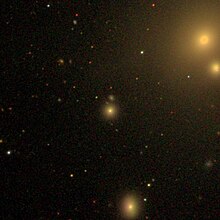
NGC 2537 is a blue compact dwarf galaxy in the constellation Lynx, located around 3 degrees NNW of 31 Lyncis. This is Arp 6 or Mrk 86. It belongs to the iE class of Blue Compact Dwarf (BCD) classification, which is described as galactic spectra with an underlying smooth elliptical Low Surface Brightness component with a superimposed "knotted" star formation component.

NGC 2552 is a Magellanic spiral galaxy located some 22 million light years away in the faint northern constellation of Lynx. This is a type of unbarred dwarf galaxy, usually with a single spiral arm. It is inclined by 41° to the line of sight from the Earth along a position angle of 229°. The measured velocity dispersion of the stars in NGC 2552 is relatively low—a mere 19 ± 2 km/s. This galaxy forms part of a loose triplet that includes NGC 2541 and NGC 2500, which together belong to the NGC 2841 group.
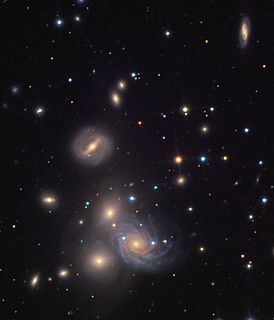
NGC 70 is a spiral galaxy located in the constellation Andromeda. It was discovered on October 7, 1855 by R. J. Mitchell and was also observed on December 19, 1897 by Guillaume Bigourdan from France who described it as "extremely faint, very small, round, between 2 faint stars"

NGC 428 is a barred spiral galaxy in the constellation of Cetus, with its spiral structure distorted and warped, possibly the result of the collision of two galaxies. There appears to be a substantial amount of star formation occurring within NGC 428 and lacks well defined arms — a telltale sign of a galaxy merger. In 2015 the Hubble Space Telescope made a close-up shot of the galaxy with its Advanced Camera for Surveys and its Wide Field and Planetary Camera 2. The structure of NGC 428 has been compared to NGC 5645.

NGC 6221 is a barred spiral galaxy located in the constellation Ara. In de Vaucouleurs' galaxy morphological classification scheme, it is classified as SB(s)bc and was discovered by British astronomer John Herschel on 3 May 1835. NGC 6221 is located at about 69 million light years from Earth.

NGC 128 is a lenticular galaxy in the constellation Pisces. It is approximately 190 million light-years from the Sun and has a diameter of about 165,000 light-years.

NGC 375 is an elliptical galaxy located in the constellation Pisces. It was discovered on September 12, 1784 by William Herschel. It was described by Dreyer as "pretty faint, small, round, brighter middle." Along with galaxies NGC 379, NGC 380, NGC 382, NGC 383, NGC 384, NGC 385, NGC 386, NGC 387 and NGC 388, NGC 375 forms a galaxy cluster called Arp 331.
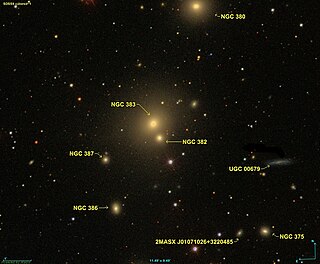
NGC 382 is an elliptical galaxy located in the constellation Pisces. Its discovery has been credited to William Parsons.

NGC 380 is an elliptical galaxy located in the constellation Pisces. It was discovered on September 12, 1784 by William Herschel. It was described by Dreyer as "pretty faint, small, round, suddenly brighter middle." Along with galaxies NGC 375, NGC 379, NGC 382, NGC 383, NGC 384, NGC 385, NGC 386, NGC 387 and NGC 388, NGC 380 forms a galaxy cluster called Arp 331.

NGC 384 is an elliptical galaxy located in the constellation Pisces. It was discovered on November 4, 1850 by Bindon Stoney. It was described by Dreyer as "pretty faint, pretty small, southwestern of 2.", the other being NGC 385. Along with galaxies NGC 375, NGC 379, NGC 382, NGC 383, NGC 385, NGC 386, NGC 387 and NGC 388, NGC 384 forms a galaxy cluster called Arp 331.
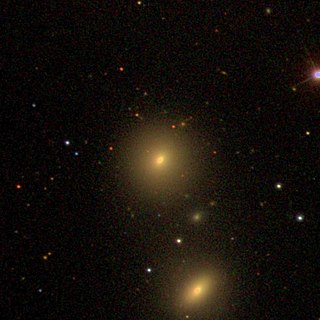
NGC 385 is an unbarred lenticular galaxy located in the constellation Pisces. It was discovered on November 4, 1850 by Bindon Stoney. It was described by Dreyer as "pretty faint, pretty small, round, northeastern of 2.", the other being NGC 384. Along with galaxies NGC 375, NGC 379, NGC 382, NGC 383, NGC 384, NGC 386, NGC 387 and NGC 388, NGC 385 forms a galaxy cluster called Arp 331.
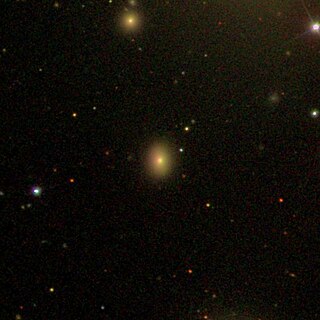
NGC 386 is an elliptical galaxy located in the constellation Pisces. It was discovered on November 4, 1850 by Bindon Stoney. It was described by Dreyer as "considerably faint, small, round." Along with galaxies NGC 375, NGC 379, NGC 382, NGC 383, NGC 384, NGC 385, NGC 387 and NGC 388, NGC 386 forms a galaxy cluster called Arp 331.

NGC 388 is an elliptical galaxy located in the constellation Pisces. It was discovered on November 4, 1850, by Bindon Stoney. It was described by Dreyer as "very faint, small, round." Along with galaxies NGC 375, NGC 379, NGC 382, NGC 383, NGC 384, NGC 385, NGC 386 and NGC 387, NGC 388 forms a galaxy cluster called Arp 331.

NGC 4274 is a barred spiral galaxy located in the constellation Coma Berenices. It is located at a distance of circa 45 million light years from Earth, which, given its apparent dimensions, means that NGC 4274 is about 95,000 light years across. It was discovered by William Herschel in 1785.

NGC 4429 is a lenticular galaxy located about 55 million light-years away in the constellation of Virgo. NGC 4429 is tilted at an inclination of about 75° which means that the galaxy is tilted almost edge-on as seen from Earth. NGC 4429 was discovered by astronomer William Herschel on March 15, 1784. The galaxy is a member of the Virgo Cluster.

NGC 4570 is an edge-on lenticular galaxy located about 57 million light-years away in the constellation Virgo. NGC 4570 was discovered by astronomer William Herschel on April 13, 1784 and is a member of the Virgo Cluster.

NGC 4596 is a barred lenticular galaxy located about 55 million light-years away in the constellation Virgo. NGC 4596 was discovered by astronomer William Herschel on March 15, 1784. The unofficial name is Tiffany's Epiphany. NGC 4596 is a member of the Virgo Cluster and has an inclination of about 38°.

NGC 2936 is an interacting spiral galaxy located at a distance of 326 million light years, in the constellation Hydra. NGC 2936 is interacting with elliptical galaxy NGC 2937, located just beneath it. They were both discovered by Albert Marth on Mar 3, 1864. To some astronomers, the galaxy looks like a penguin or a porpoise. NGC 2936, NGC 2937, and PGC 1237172 are included in the Atlas of Peculiar Galaxies as Arp 142 in the category "Galaxy triplet".
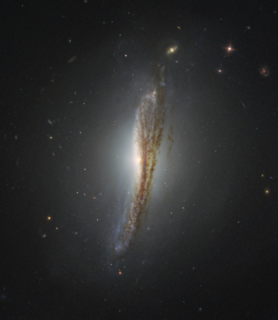
NGC 612 is a lenticular galaxy in the constellation of Sculptor located approximately 388 million light-years from Earth. It is a type II Seyfert galaxy and thus has an active galactic nucleus. NGC 612 has been identified as an extremely rare example of a non-elliptical radio galaxy, hosting one of the nearest powerful FR-II radio sources.

NGC 1439 is an elliptical galaxy located in constellation of Eridanus. Situated about 77 million light years away, it is a member of the Eridanus cluster of galaxies, a cluster of about 200 galaxies. It was discovered by William Herschel on 9 December 1784.
